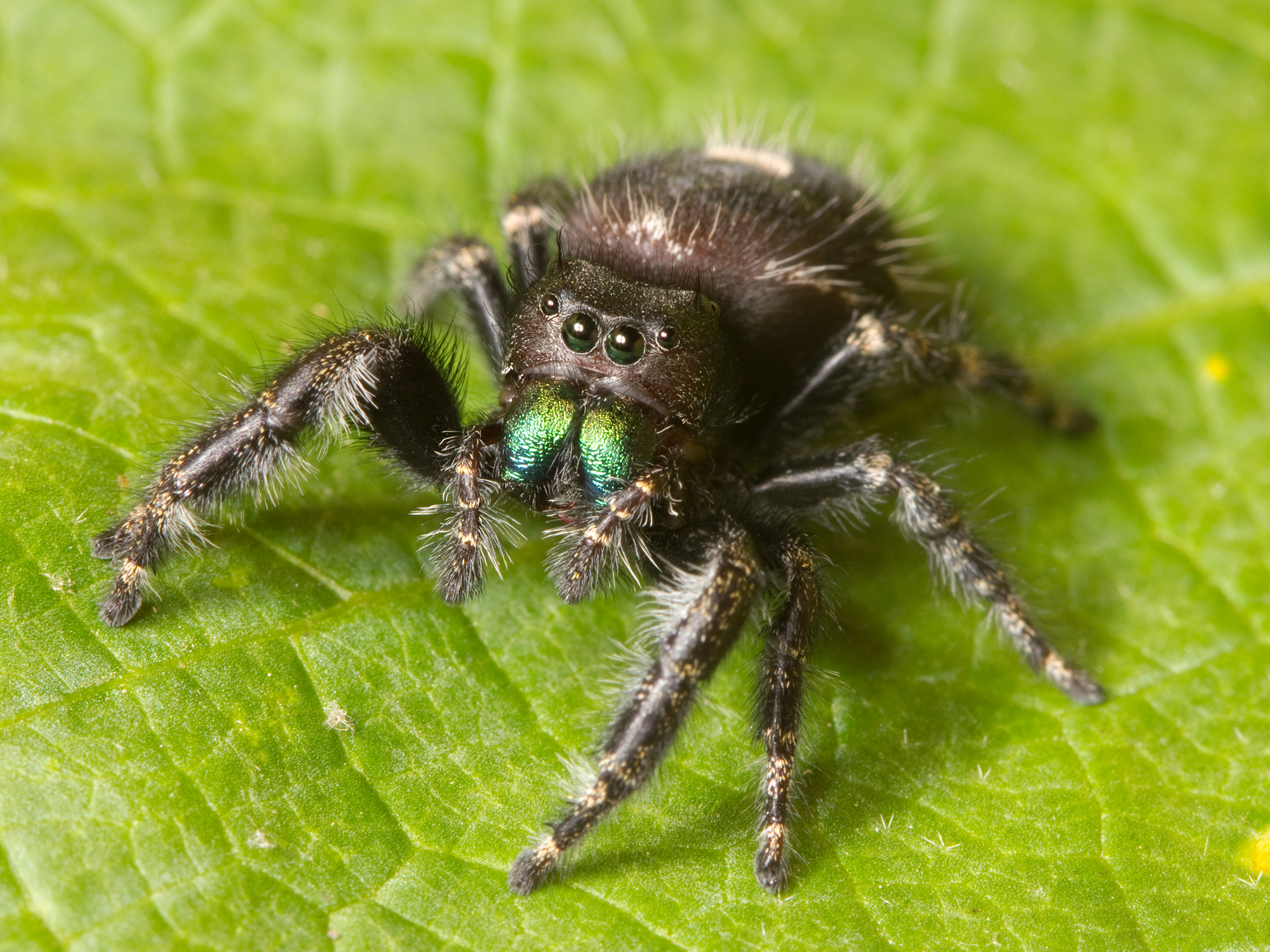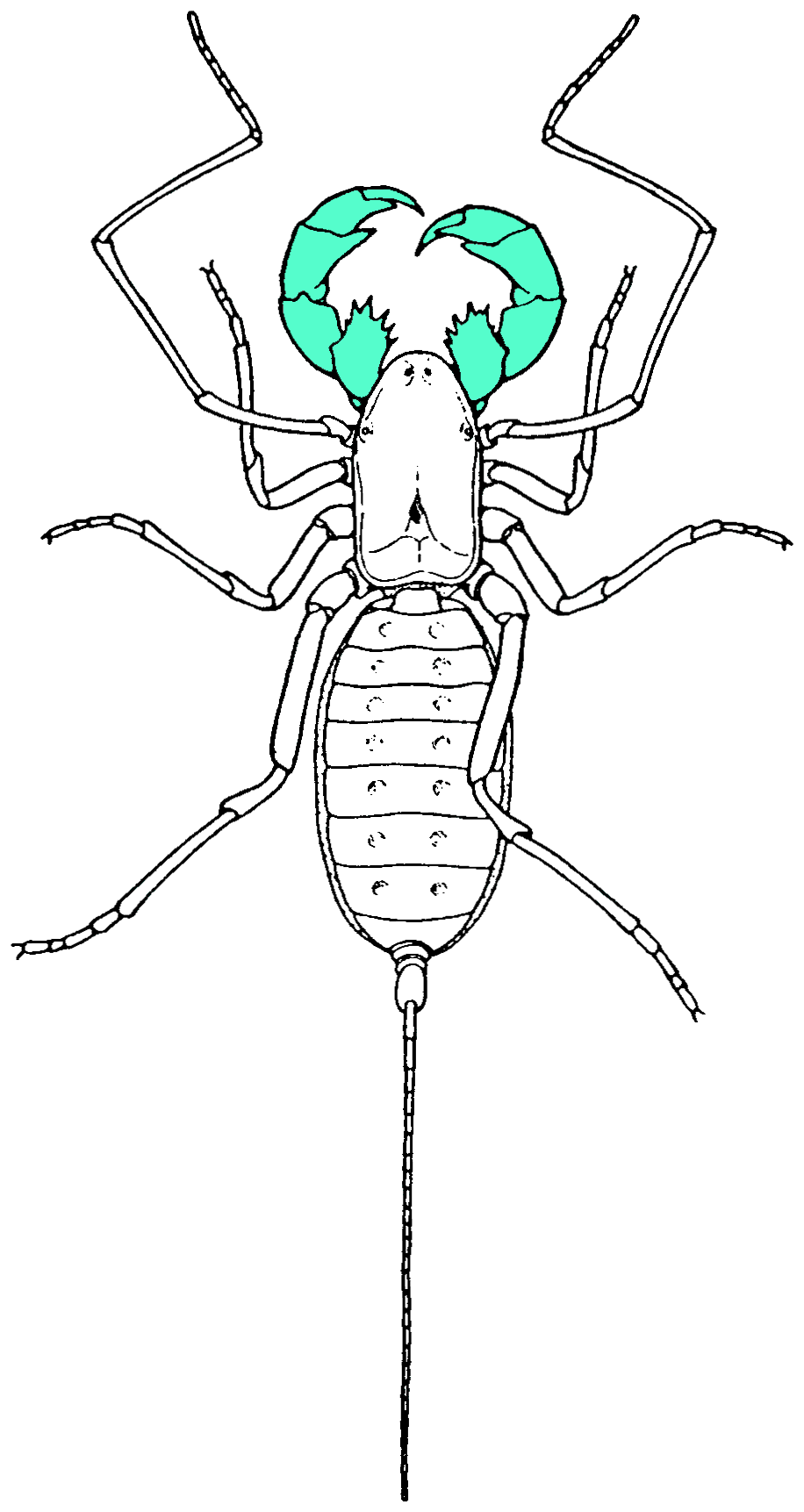|
Amblypygi
Amblypygi is an order of arachnids also known as whip-spiders or tailless whip-scorpions, not to be confused with whip-scorpions or vinegaroons that belong to the related order Thelyphonida. The name "amblypygid" means "blunt tail", a reference to a lack of the flagellum that is otherwise seen in whip-scorpions. Amblypygids possess no silk glands or venom. They rarely bite if threatened but can grab fingers with their pedipalps, resulting in thorn-like puncture-injuries. As of 2023, five families, 17 genera, and around 260 species had been discovered and described. They are found in tropical and subtropical regions worldwide, mainly in warm and humid environments. They like to stay protected and hidden within leaf litter, caves, or underneath bark. Some species are subterranean; all are nocturnal. Fossilized amblypygids have been found dating back to the Carboniferous period, such as '' Weygoldtina''. Description Body-plan Being arachnids, Amblypygi possess two body-segm ... [...More Info...] [...Related Items...] OR: [Wikipedia] [Google] [Baidu] |
Paracharontidae
Paracharontidae is an arachnid family within the order Amblypygi (tailless whip scorpions). Paracharontidae and the extinct Weygoldtinidae from the Carboniferous form the suborder Paleoamblypygi, the sister group to the remaining Amblypygi. The family contains two genera: '' Paracharon'', containing the single species ''Paracharon caecus'' Hansen, 1921 from Guinea-Bissau in West Africa, and '' Jorottui'' with the single species ''Jorottui ipuanai'' from Colombia in northern South America. '' Paracharonopsis'' from the Eocene (Ypresian In the geologic timescale the Ypresian is the oldest age (geology), age or lowest stage (stratigraphy), stratigraphic stage of the Eocene. It spans the time between , is preceded by the Thanetian Age (part of the Paleocene) and is followed by th ...) aged Cambay amber of India was initially assigned to this family but this was later questioned and it has since been reassigned to Euamblypygi. Both living species are troglobites, having no eyes, ... [...More Info...] [...Related Items...] OR: [Wikipedia] [Google] [Baidu] |
Arachnids
Arachnids are arthropods in the class Arachnida () of the subphylum Chelicerata. Arachnida includes, among others, spiders, scorpions, ticks, mites, pseudoscorpions, harvestmen, camel spiders, whip spiders and vinegaroons. Adult arachnids have eight legs attached to the cephalothorax. In some species the frontmost pair of legs has converted to a sensory function, while in others, different appendages can grow large enough to take on the appearance of extra pairs of legs. Almost all extant arachnids are terrestrial, living mainly on land. However, some inhabit freshwater environments and, with the exception of the pelagic zone, marine environments as well. They comprise over 110,000 named species, of which 51,000 are species of spiders. The term is derived from the Greek word (''aráchnē'', 'spider'), from the myth of the hubristic human weaver Arachne, who was turned into a spider. Morphology Almost all adult arachnids have eight legs, unlike adult insects whic ... [...More Info...] [...Related Items...] OR: [Wikipedia] [Google] [Baidu] |
Uropygi
Uropygi is an arachnid order comprising invertebrates commonly known as whip scorpions or vinegaroons (also spelled vinegarroons and vinegarones). They are often called uropygids. The name "whip scorpion" refers to their resemblance to scorpion, true scorpions and possession of a whiplike tail, and "vinegaroon" refers to their ability when attacked to discharge an offensive, vinegar-smelling liquid, which contains acetic acid. The order may also be called Thelyphonida. Both names, Uropygi and Thelyphonida, may be used either in a narrow sense for the order of whip scorpions, or in a broad sense which includes the order Schizomida. Taxonomy Carl Linnaeus first described a whip scorpion in 1758, although he did not distinguish it from what are now regarded as different kinds of arachnid, calling it ''Phalangium caudatum''. ''Phalangium'' is now used as a name for a genus of harvestmen (Opiliones). In 1802, Pierre André Latreille was the first to use a genus name solely for whip s ... [...More Info...] [...Related Items...] OR: [Wikipedia] [Google] [Baidu] |
Phrynidae
Phrynidae is a Family (biology), family of amblypygid chelicerata, arachnida arthropods also known as whip spiders and tailless whip scorpions. Phrynidae species are found in tropics, tropical and subtropics, subtropical regions in North and South America. Some species are subterranean; all are nocturnal. At least some species of Phrynidae hold territories that they defend from other individuals. Taxonomy The following genera are recognised: ;Phrynidae Blanchard, 1852 *''Acanthophrynus'' Kraepelin, 1899 (1 species) *†''Britopygus'' Dunlop & Martill, 2002 (1 species; Crato Formation, Brazil, Early Cretaceous (Aptian extinction, Aptian)) *†''Electrophrynus'' Petrunkevich, 1971 Chiapas amber, Mexico, Miocene (''nomen dubium'') *''Heterophrynus'' Pocock, 1894 (17 species) *''Paraphrynus'' Moreno, 1940 (18 species) *''Phrynus'' Lamarck, 1801 (28 species, Oligocene - Recent) References External links * {{Taxonbar, from=Q3381696 Amblypygi, Arachnid orders Extant Pennsylv ... [...More Info...] [...Related Items...] OR: [Wikipedia] [Google] [Baidu] |
Weygoldtina
''Weygoldtina'' is an extinct genus of tailless whip scorpion known from Carboniferous period, and the only known member of the family Weygoldtinidae. It is known from two species described from North America and England and originally described in the genus ''Graeophonus'', which is now considered a ''nomen dubium''. History A single fossil from the Cape Breton Island was interpreted as a fossil dragonfly larva and described by Samuel Hubbard Scudder in 1876 as ''Libellula carbonaria''. The fossil was very incomplete, consisting of a solitary opisthosoma. With the discovery of more complete fossils from Mazon Creek, Illinois, and Joggins, Nova Scotia, Samuel Scudder redescribed the fossils as amblypygids and moved the species to a new genus, ''Graeophonus'' as ''Graeophonus carbonarius''. While describing the British species, ''Graeophonus anglicus'', Reginald Innes Pocock noted significant differences between the Nova Scotian and more complete Mazon Creek fossils. As a res ... [...More Info...] [...Related Items...] OR: [Wikipedia] [Google] [Baidu] |
Weygoldtinidae
''Weygoldtina'' is an extinct genus of Amblypygi, tailless whip scorpion known from Carboniferous period, and the only known member of the family Weygoldtinidae. It is known from two species described from North America and England and originally described in the genus ''Graeophonus'', which is now considered a ''nomen dubium''. History A single fossil from the Cape Breton Island was interpreted as a fossil dragonfly larva and described by Samuel Hubbard Scudder in 1876 as ''Libellula carbonaria''. The fossil was very incomplete, consisting of a solitary opisthosoma. With the discovery of more complete fossils from Mazon Creek fossil beds, Mazon Creek, Illinois, and Joggins, Nova Scotia, Samuel Scudder redescribed the fossils as amblypygids and moved the species to a new genus, ''Graeophonus'' as ''Graeophonus carbonarius''. While describing the British species, ''Graeophonus anglicus'', Reginald Innes Pocock noted significant differences between the Nova Scotian and more compl ... [...More Info...] [...Related Items...] OR: [Wikipedia] [Google] [Baidu] |
Charinidae
Charinidae is an arachnid Arachnids are arthropods in the Class (biology), class Arachnida () of the subphylum Chelicerata. Arachnida includes, among others, spiders, scorpions, ticks, mites, pseudoscorpions, opiliones, harvestmen, Solifugae, camel spiders, Amblypygi, wh ... family within the order of tailless whip scorpions.Harvey, M.S. 2003. Order Amblypygi. pp. 59–99 in, Catalogue of the Smaller Arachnid Orders of the World: Amblypygi, Uropygi, Schizomida, Palpigradi, Ricinulei and Solifugae. Collingwood, Victoria : CSIRO Publishing. 385 pp. Genera There are four genera in the family Charinidae. *'' Catageus'' Thorell, 1889 *'' Charinus'' Simon, 1892 *'' Sarax'' Simon, 1892 *'' Weygoldtia'' Miranda, Giupponi, Prendini & Scharff, 2018 References External links ITISAustralian Faunal Directory Amblypygi Arachnid families {{arachnid-stub ... [...More Info...] [...Related Items...] OR: [Wikipedia] [Google] [Baidu] |
Charontidae
''Charon'' is a genus of whip-spiders from Asia and Australasia, first described by Ferdinand Karsch Ferdinand Anton Franz Karsch (2 September 1853, in Münster – 20 December 1936, in Berlin) was a German arachnologist, entomologist and anthropologist. He also wrote on human and animal sexual diversity with his mother's maiden name included a ... in 1879. Species , the ''World Amblypygi Catalog'' accepted the following six species: * Charon dantei Réveillion & Maquart, 2018 — La Réunion * '' Charon ambreae'' Réveillion & Maquart, 2018 — Taiwan * '' Charon forsteri'' (Dunn, 1949) — Solomon Islands * '' Charon gervaisi'' Harvey & West, 1998 — Christmas Island * '' Charon grayi'' (Gervais, 1842) — Southeast Asia * '' Charon oenpelli'' Harvey & West, 1998 — Australia * '' Charon trebax'' Harvey & West, 1998 — Australia References Amblypygi Arachnid genera {{arachnid-stub ... [...More Info...] [...Related Items...] OR: [Wikipedia] [Google] [Baidu] |
Phrynichidae
Phrynichidae is a family of arachnid Arachnids are arthropods in the Class (biology), class Arachnida () of the subphylum Chelicerata. Arachnida includes, among others, spiders, scorpions, ticks, mites, pseudoscorpions, opiliones, harvestmen, Solifugae, camel spiders, Amblypygi, wh ...s. Distribution The species of this family are found in Africa, South Asia and South America. Genera * Damoninae Simon, in Fage & Simon 1936 ** '' Damon'' C. L. Koch, 1850 ** '' Musicodamon'' Fage, 1939 ** '' Phrynichodamon'' Weygoldt, 1996 * Phrynichinae Simon, 1892 ** '' Euphrynichus'' Weygoldt, 1995 ** '' Phrynichus'' Karsch, 1879 ** '' Trichodamon'' Mello-Leitao, 1935 * indefinite subfamily ** '' Xerophrynus'' Weygoldt, 1996 References *Simon, 1892 : Arachnides. Etude sur les Arthropodes cavernicoles de île Luzon, Voyage de M. E. Simon aux îles Philippines (Mars et avril 1890), Annales de la Société Entomologique de France, vol. 61, p. 35–52. *Harvey, Mark S. 2003-01-01. Catalog ... [...More Info...] [...Related Items...] OR: [Wikipedia] [Google] [Baidu] |
Phrynichus Phipsoni – Pocock, 1900
Phrynichus (Greek: ) may refer to: People *Phrynichus (tragic poet) or Phrynichus Tragicus (6th-5th century BC), abbreviated in lexica as hryn.Trag. pioneer of Greek tragedy, most famous for ''The Fall of Miletus'' *Phrynichus (comic poet) Phrynichus (; ) was a poet of the Old Attic comedy and a contemporary of Aristophanes. His first comedy was exhibited in 429 BC. He composed ten plays, of which the ''Recluse'' was exhibited at the City Dionysia in 414 along with the ''Birds'' of ... or Phrynichus Comicus (late 5th century BC), abbreviated in lexica as hryn.Com. writer of old Attic comedy * Phrynichus (oligarch) (died 411 BC), Athenian general during the Peloponnesian War who took a leading part in establishing the oligarchy of the Four Hundred * Phrynichus Arabius or Phrynichus Atticista (2nd century AD), abbreviated in lexica as hryn. grammarian and rhetorician Animals * ''Phrynichus'' (arachnid), a genus in the order Amblypygi {{disambig, hndis ... [...More Info...] [...Related Items...] OR: [Wikipedia] [Google] [Baidu] |
Chelicerae
The chelicerae () are the arthropod mouthparts, mouthparts of the subphylum Chelicerata, an arthropod group that includes arachnids, horseshoe crabs, and sea spiders. Commonly referred to as "jaws", chelicerae may be shaped as either articulated fangs, or as a type of pincer_(biology), pincers. Some chelicerae, such as those found on nearly all spiders, are hollow and contain (or are connected to) venom glands, used to inject venom into prey or a perceived threat. Both pseudoscorpions and Opiliones , harvestmen have additional structures on their chelicerae that are used for grooming (papillae in pseudoscorpions, cheliceral teeth in Opiliones). In ''Paratrechalea'', males and females have shown to have a chelicerae dimorphism, because the chelicerae is used as a mating signal for females. Types Chelicerae can be divided into three kinds: jackknife chelicerae, scissor chelicerae, and three-segmented wikt:chelate, chelate chelicerae. Jackknife chelicerae The jackknife chelicer ... [...More Info...] [...Related Items...] OR: [Wikipedia] [Google] [Baidu] |
Pedipalps
Pedipalps (commonly shortened to palps or palpi) are the secondary pair of forward appendages among Chelicerata, chelicerates – a group of arthropods including spiders, scorpions, horseshoe crabs, and sea spiders. The pedipalps are lateral to the chelicerae ("jaws") and anterior to the first pair of walking legs. Overview Pedipalps are composed of six segments or articles. From the proximal end (where they are attached to the body) to the distal, they are: the coxa, the Arthropod leg#Trochanter, trochanter, the Arthropod leg#Femur, femur, the short Glossary_of_spider_terms#patella, patella, the Glossary_of_spider_terms#tibia, tibia, and the Arthropod_leg#Tarsus, tarsus. In spiders, the coxae frequently have extensions called Glossary_of_spider_terms#maxilla , maxillae or gnathobases, which function as mouth parts with or without some contribution from the coxae of the anterior arthropod leg, legs. The limbs themselves may be simple tactile organs outwardly resembling the legs ... [...More Info...] [...Related Items...] OR: [Wikipedia] [Google] [Baidu] |





